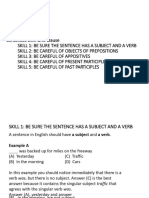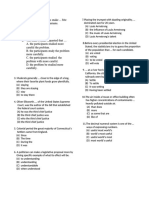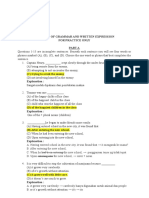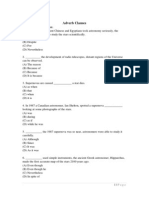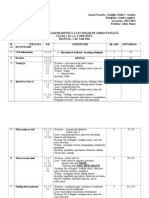Cambridge Preparation For The TOEFL (R) Test, 3/E: Test 1 Structure Answer Key
Cambridge Preparation For The TOEFL (R) Test, 3/E: Test 1 Structure Answer Key
Uploaded by
Fajar Fikriyansyah SidikCopyright:
Available Formats
Cambridge Preparation For The TOEFL (R) Test, 3/E: Test 1 Structure Answer Key
Cambridge Preparation For The TOEFL (R) Test, 3/E: Test 1 Structure Answer Key
Uploaded by
Fajar Fikriyansyah SidikOriginal Title
Copyright
Available Formats
Share this document
Did you find this document useful?
Is this content inappropriate?
Copyright:
Available Formats
Cambridge Preparation For The TOEFL (R) Test, 3/E: Test 1 Structure Answer Key
Cambridge Preparation For The TOEFL (R) Test, 3/E: Test 1 Structure Answer Key
Uploaded by
Fajar Fikriyansyah SidikCopyright:
Available Formats
Cambridge Preparation for the TOEFL (R) Test, 3/E
Test 1 Structure Answer Key
Copyright (c) 2002 by Cambridge University Press
1. ANSWER: fly
EXPLANATION: A verb in the simple present tense, "fly," is needed to complete the
sentence.
CORRECT SENTENCE: Not all birds fly.
2. ANSWER: disturbing
EXPLANATION: The nouns "predators" and "pollution" are used as subjects.
Therefore, the word "disturbing" needs to be in the noun form "disturbances" to be a
part of the parallel structure.
CORRECT SENTENCE: Natural predators, disturbances from tourists, and
pollution have all contributed to the decline of the California condor.
3. ANSWER: fitted together
EXPLANATION: The adjective clause "that can be" is incomplete. A verb, "fitted,"
can complete the clause. "Together" tells how the parts fit.
CORRECT SENTENCE: A construction kit consists of parts that can be fitted
together.
4. ANSWER: old
EXPLANATION: The superlative form "oldest" should be used because Soay sheep
are being compared to all other breeds of sheep.
CORRECT SENTENCE: The Soay sheep, the oldest breed of sheep in existence,
has changed little since 3500 B.C.E.
5. ANSWER: Alfred B. Nobel left money to be awarded
EXPLANATION: A verb is needed to complete the independent clause. "Alfred B.
Nobel" identifies the Swedish scientist who "left money to be awarded."
CORRECT SENTENCE: The Swedish scientist Alfred B. Nobel left money to be
awarded to people who have done something important to help humankind.
6. ANSWER: the village
EXPLANATION: The plural noun "villages" should be used. "Some" indicates that
there is more than one village.
CORRECT SENTENCE: A traveler can reach some of the villages along the
Amazon only by riverboat.
7. ANSWER: does
EXPLANATION: An aux-word (auxiliary verb), "does," is needed to complete the
sentence.
CORRECT SENTENCE: The western part of Oregon generally receives more rain
than does the eastern part.
Test 1 Structure Answer Key | 7/21/2018 | Page 1
8. ANSWER: is important
EXPLANATION: An article is needed in the noun phrase "important element." The
article "an" should be used because it precedes a vowel sound.
CORRECT SENTENCE: Fiber is an important element in nutrition, and it aids in
protecting the digestive tract as well.
9. ANSWER: Like
EXPLANATION: "Like," meaning "similar to," is a preposition that indicates a
comparison. Here there is a comparison between "porpoises and dolphins" and
"whales."
CORRECT SENTENCE: Like porpoises and dolphins, whales are mammals.
10. ANSWER: settlement
EXPLANATION: "Settlement" is a noun that refers to a place. The noun form
"settlers" is used for people.
CORRECT SENTENCE: The first European settlers of Australia left the city of
Portsmouth in May 1787.
11. ANSWER: Although founded many centuries earlier
EXPLANATION: The independent clause is complete, indicating that a clause or
phrase is needed to fill in the blank. "Although" introduces the reduced adverb
clause "founded many centuries earlier."
CORRECT SENTENCE: Although founded many centuries earlier, Luxor did not
reach preeminence until about 2000 B.C.E.
12. ANSWER: them
EXPLANATION: "Which" is the object of the adjective clause and refers to
"nutrients." The pronoun "them" cannot be used to fill the same position and
therefore must be removed for the sentence to be correct.
CORRECT SENTENCE: Starches provide people with important nutrients which
they need.
13. ANSWER: It was while
EXPLANATION: A subject and verb are needed to complete the sentence. The
word "it" fills the subject position, and the verb "was" fills the verb position. An
adverb, "while," is needed to introduce the adverb phrase "living in Birmingham,
England."
CORRECT SENTENCE: It was while living in Birmingham, England, that the
American writer Washington Irving wrote Rip Van Winkle.
14. ANSWER: their
EXPLANATION: The possessive adjective "its" should be used instead of "their"
because it refers to "Bactrian camel," which is used in the singular form indicating a
class of animal.
CORRECT SENTENCE: The Bactrian, or Asian, camel can be identified by its two
humps.
15. ANSWER: Who built the stone circle
Test 1 Structure Answer Key | 7/21/2018 | Page 2
EXPLANATION: The verb in the passive voice "has never been determined" needs
a subject that indicates what hasn't yet been determined. "Who built the stone
circle" fills that position.
CORRECT SENTENCE: Who built the stone circle known as "Stonehenge" has
never been determined.
16. ANSWER: outsider
EXPLANATION: The noun "outsider" should be in the plural form, "outsiders." The
article "an" would have been included if there had been only one outsider who ruled
Catalonia.
CORRECT SENTENCE: A trade center since antiquity, Catalonia itself has often
been ruled by outsiders.
17. ANSWER: indicating the location of their discovery
EXPLANATION: An adjective clause or adjective phrase is needed to modify the
noun "terms." The phrase "indicating the location of their discovery" describes what
kind of terms.
CORRECT SENTENCE: Certain Paleolithic artifacts are given special terms
indicating the location of their discovery.
18. ANSWER: in the air
EXPLANATION: The phrase "in the air" is redundant because "in the air" means the
same as the word "aloft." The sentence should read, "Early balloonists remained
aloft for relatively short periods."
CORRECT SENTENCE: Early balloonists remained aloft for relatively short periods.
19. ANSWER: how remarkable it seems
EXPLANATION: An adverb clause is needed to complete the sentence. The word
order for an adverb clause introduced by the clause marker "how" is: "how" +
adjective + subject + verb.
CORRECT SENTENCE: No matter how remarkable it seems, Mozart was an
accomplished composer while still a child.
20. ANSWER: but
EXPLANATION: "Simulations" is not being contrasted with "training." Therefore, the
two nouns should be joined by the word "and."
CORRECT SENTENCE: At space camp, youngsters go through concentrated
astronaut training and shuttle simulations.
Test 1 Structure Answer Key | 7/21/2018 | Page 3
You might also like
- Subject Verb Agreement PPT SPDocument29 pagesSubject Verb Agreement PPT SPVivek RanjanNo ratings yet
- A Suffix Based Morphological Analysis of Assamese Word FormationDocument5 pagesA Suffix Based Morphological Analysis of Assamese Word FormationEditor IJRITCC100% (2)
- Affirmative Negative: Long Form Short Form Long FormDocument4 pagesAffirmative Negative: Long Form Short Form Long Formdsanchez107100% (1)
- Central Course - Section 2 - Central Course - Central CourseDocument8 pagesCentral Course - Section 2 - Central Course - Central Coursemilatrikanti80No ratings yet
- (D) AlthoughDocument4 pages(D) AlthoughRinaldi Ismail DaulayNo ratings yet
- Exercise 2 (Listening Skill 2 PG 32)Document13 pagesExercise 2 (Listening Skill 2 PG 32)tessautariNo ratings yet
- Structure and Written Expression Practice SetsDocument6 pagesStructure and Written Expression Practice Setsfirda yuliani100% (1)
- Skills 9-10Document6 pagesSkills 9-10TegarNo ratings yet
- Kunjaw TOEFL 3Document3 pagesKunjaw TOEFL 3fauzanakbbarNo ratings yet
- Structure and Written Expression Skill 1 - 10Document34 pagesStructure and Written Expression Skill 1 - 1019231234No ratings yet
- B. Inggris Kel.1 (Skil 20 - 25)Document26 pagesB. Inggris Kel.1 (Skil 20 - 25)handaNo ratings yet
- Structure 1Document81 pagesStructure 1Muhammad FuadNo ratings yet
- StructureDocument5 pagesStructureDimas Mahardika IlmiNo ratings yet
- Skill 13 Listen For Emphatic Expressions of SurpriseDocument5 pagesSkill 13 Listen For Emphatic Expressions of SurpriseElbi AlfariziNo ratings yet
- Day 3B - Incomplete Noun ClauseDocument3 pagesDay 3B - Incomplete Noun ClausecarissapiNo ratings yet
- TOEFL Meeting 11Document18 pagesTOEFL Meeting 11Rini FitriastutiNo ratings yet
- Toefl Exercise 02Document2 pagesToefl Exercise 02Maulidya SilvianaNo ratings yet
- Pembahasan Handbook Week 4Document3 pagesPembahasan Handbook Week 4Muh KhairurrozikinNo ratings yet
- Nugroho Syahputra - TOEFL Exercise 20-21 (Inversion)Document5 pagesNugroho Syahputra - TOEFL Exercise 20-21 (Inversion)NET BINARYNo ratings yet
- Nugroho Syahputra - TOEFL Exercise 17 (Comparatives Superlatives)Document2 pagesNugroho Syahputra - TOEFL Exercise 17 (Comparatives Superlatives)NET BINARYNo ratings yet
- Questions 1 Through 10 Are Based On The Following PassageDocument6 pagesQuestions 1 Through 10 Are Based On The Following PassageBerlianamitaNo ratings yet
- Part 3 - Skill 3 - Avoid Similar SoundsDocument4 pagesPart 3 - Skill 3 - Avoid Similar SoundsAnvitriaNo ratings yet
- Materi Pertemuan 4 Qh121 Allowed by MGRDocument2 pagesMateri Pertemuan 4 Qh121 Allowed by MGRErika GarniyatiNo ratings yet
- Skill 9 Listen For "Almost Negative"Document4 pagesSkill 9 Listen For "Almost Negative"Elbi AlfariziNo ratings yet
- Test 2Document4 pagesTest 2Bách NguyễnNo ratings yet
- Soal TOEFLDocument11 pagesSoal TOEFLKristiNo ratings yet
- TOEFL Structure ZicDocument6 pagesTOEFL Structure ZicHelmi Mukti WijayaNo ratings yet
- Skill3: Unstated Detail QuestionsDocument15 pagesSkill3: Unstated Detail QuestionsHan Hye MinNo ratings yet
- Soal TOEFL ReadingDocument12 pagesSoal TOEFL ReadingDiva Aulia100% (1)
- Endang MaimunahDocument14 pagesEndang MaimunahShela NabilaNo ratings yet
- 100 Soal TOEFL Exersice & Answer KeyDocument47 pages100 Soal TOEFL Exersice & Answer Keyiskah030No ratings yet
- Practice TOEFL StructureDocument2 pagesPractice TOEFL StructureacengNo ratings yet
- 04.TOEFL-Reading StrategyDocument9 pages04.TOEFL-Reading StrategyAldy FarezaNo ratings yet
- AGR 1 - 210301059 - ALGHI FAHRY LESMANA - Assignment 6Document5 pagesAGR 1 - 210301059 - ALGHI FAHRY LESMANA - Assignment 6Alghi FahryNo ratings yet
- Soal TOEFL Latihan Ke-1Document5 pagesSoal TOEFL Latihan Ke-1ayu lestariNo ratings yet
- Toefl-Prediction Test: Laboratorium Bahasa Universitas Wijayakusuma PurwokertoDocument25 pagesToefl-Prediction Test: Laboratorium Bahasa Universitas Wijayakusuma PurwokertofauzanNo ratings yet
- Reading Toefl ComprehensionDocument19 pagesReading Toefl ComprehensionTariza FitriaNo ratings yet
- Written Expression TestDocument4 pagesWritten Expression TestChristian Yael Aguilar AcevedoNo ratings yet
- Mini-Test of Grammar and Written ExpressionDocument7 pagesMini-Test of Grammar and Written ExpressionAdinda Oktaviani SaktiNo ratings yet
- SOAL ToeflDocument2 pagesSOAL ToeflAri WidyatiNo ratings yet
- Contoh Soal ToeflDocument8 pagesContoh Soal ToeflMuhammad Muthohari ShahabNo ratings yet
- Chapter 7Document12 pagesChapter 7Saleha RidhoNo ratings yet
- Toefl PDFDocument7 pagesToefl PDFEoudia MargarethaNo ratings yet
- I@Ionatic Language: Skill I6: Listen Fortwo-And Three-PartverbsDocument7 pagesI@Ionatic Language: Skill I6: Listen Fortwo-And Three-PartverbsEnrique TopeteNo ratings yet
- Complete Grammar ExerciseDocument59 pagesComplete Grammar Exercisezilva karimahNo ratings yet
- InferDocument5 pagesInferAlex Ruiz BrionesNo ratings yet
- Soal TbiDocument6 pagesSoal TbiAstrid Dita NafilahNo ratings yet
- Kelas Toefl Jilc: Reading ComprehensionDocument11 pagesKelas Toefl Jilc: Reading ComprehensionRANINo ratings yet
- Tugas 3: Contoh Kalimat Toefl Appositive: C. One of The Iconic Train Trips in The WorldDocument5 pagesTugas 3: Contoh Kalimat Toefl Appositive: C. One of The Iconic Train Trips in The WorldReka Mulya100% (1)
- Sample Questions - Skill 4Document5 pagesSample Questions - Skill 4johnNo ratings yet
- TOEFLDocument24 pagesTOEFLwahyuNo ratings yet
- Drilling TOEFL ListeningDocument2 pagesDrilling TOEFL ListeningSofa Yuliansyah100% (3)
- Toefl Skill 18-21Document2 pagesToefl Skill 18-21Clara Widya Mulya MNo ratings yet
- Tugas Toefl "Reading Comprehension"Document11 pagesTugas Toefl "Reading Comprehension"veviola fitri100% (1)
- Tugas 12 B. Inggris Reza FirgiantiDocument6 pagesTugas 12 B. Inggris Reza FirgiantiFera NurjanahNo ratings yet
- Toefl Test: (Section 3. Reading Comprehension)Document4 pagesToefl Test: (Section 3. Reading Comprehension)Weka patrianaNo ratings yet
- Adverb Clauses TOEFL TestDocument4 pagesAdverb Clauses TOEFL TestVeasna ChannNo ratings yet
- Section 3Document5 pagesSection 3Aryani LuthfiaNo ratings yet
- Reading Comprehension TOEFL 10 - ANSWERSDocument6 pagesReading Comprehension TOEFL 10 - ANSWERSanibeliNo ratings yet
- Toefl TestDocument12 pagesToefl TestDewi AnggraeniNo ratings yet
- Answer Keys Structure 7 February 2021Document7 pagesAnswer Keys Structure 7 February 2021anon_294803392No ratings yet
- Group_4_Assignment_Errors_with_Parallel_Structure_and_Errors_withDocument7 pagesGroup_4_Assignment_Errors_with_Parallel_Structure_and_Errors_withPutry RahmadyanNo ratings yet
- Tugas Kelompok Bahasa InggrisDocument5 pagesTugas Kelompok Bahasa InggrisliliNo ratings yet
- Lecture No.2, FDDocument37 pagesLecture No.2, FDFARHAN KHANNo ratings yet
- SentenceDocument12 pagesSentenceSumera BokhariNo ratings yet
- This Is My Family: VocabularyDocument54 pagesThis Is My Family: VocabularyARMANDO JRNo ratings yet
- Look at The Pictures and Match Them With The Correct Phrases. Write A Complete Sentence To Describe What People Are Doing!Document3 pagesLook at The Pictures and Match Them With The Correct Phrases. Write A Complete Sentence To Describe What People Are Doing!Viviana Valencia PossoNo ratings yet
- DAFTAR LENGKAP IregulerDocument20 pagesDAFTAR LENGKAP IregulerEvendy SetiawanNo ratings yet
- Fill in The Missing Word(s)Document41 pagesFill in The Missing Word(s)Arnav GuptaNo ratings yet
- The Present Perfect Tense: I Haven T Finished My Homework YetDocument1 pageThe Present Perfect Tense: I Haven T Finished My Homework YetDagoberto MartínezNo ratings yet
- GR MightDocument2 pagesGR Mightapi-304432259No ratings yet
- Learn Hindi Lesson OneDocument24 pagesLearn Hindi Lesson OneSkr9143 ShivNo ratings yet
- Verb To Be - PresentDocument11 pagesVerb To Be - PresentAketzali HRNo ratings yet
- English 2Document19 pagesEnglish 2islam hamdyNo ratings yet
- Unit 2 Present Perfect SimpleDocument14 pagesUnit 2 Present Perfect SimpleAlexis Vaca FuentesNo ratings yet
- DeutschImBlick TextbookDocument484 pagesDeutschImBlick TextbookTroy E. SpierNo ratings yet
- English Vi Q1 - WEEK 10 Day 1: Across Borders Through Reading, Integration Across The Curriculum, Pp. 24-26Document47 pagesEnglish Vi Q1 - WEEK 10 Day 1: Across Borders Through Reading, Integration Across The Curriculum, Pp. 24-26jeanne colasiNo ratings yet
- She Fell Out of My HandsDocument2 pagesShe Fell Out of My HandsDiego González SanchoNo ratings yet
- English S2 SBDocument144 pagesEnglish S2 SBpatrickkarangwa52No ratings yet
- Sastav Za IspitDocument73 pagesSastav Za IspitmostarjelicaNo ratings yet
- Dictionary 2 3Document45 pagesDictionary 2 3ნიკოლოზ ღოღობერიძეNo ratings yet
- Planificare CAE Gold Plus 2014Document5 pagesPlanificare CAE Gold Plus 2014alinasimut100% (1)
- Coaching Resource Pack Jade JoddleDocument16 pagesCoaching Resource Pack Jade JoddleSilas Cesar100% (1)
- Ryan International School, CBSE Syllabus Std. VII Academic Year 2018-19Document7 pagesRyan International School, CBSE Syllabus Std. VII Academic Year 2018-19srenathNo ratings yet
- Simple Present TenseDocument25 pagesSimple Present Tensebangkit99No ratings yet
- Grammer Exam 1.4Document5 pagesGrammer Exam 1.4tihitinadaNo ratings yet
- Grade - Viii Model Paper 2017 English: Mcqs Paper Key S. No. Key S. No. KeyDocument6 pagesGrade - Viii Model Paper 2017 English: Mcqs Paper Key S. No. Key S. No. KeyAsad JamalNo ratings yet
- Intermediate Academic EnglishDocument150 pagesIntermediate Academic EnglishDianrisNo ratings yet
- Final Test Beg Nurul MisbahDocument20 pagesFinal Test Beg Nurul Misbahvio letteNo ratings yet
- The Answer Task 6 Toefl PreparationDocument7 pagesThe Answer Task 6 Toefl PreparationEmilia AnnisaNo ratings yet









